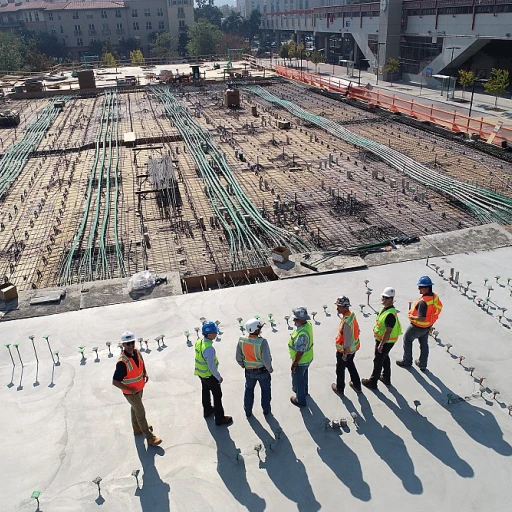
Defining Cubical and Cubicle
Unraveling the Terms in Office Settings
When discussing UK office workspaces, the terms 'cubical' and 'cubicle' might seem interchangeable, yet they signify distinct concepts. Understanding these differences is vital for employers planning their office layout. In the English language, a 'cubicle' refers to a small enclosed area designed to offer employees a level of privacy within open-plan offices. These cube-shaped units create a sense of personal office space, often found in large corporate work environments where people perform tasks requiring focus and minimal distractions. On the other hand, 'cubical' describes a three-dimensional shape resembling a cube. While it might share phonetic similarities with 'cubicle', its application in office talk is minimal, often causing confusion among English speakers when discussing workspace requirements. Office members may appreciate cubicle offices for their ability to render a semblance of privacy. These small partitioned workspaces allow for a personal touch, enhancing job satisfaction and focus in a bustling office environment. Furthermore, as the workplace design evolves, it's crucial to grasp these definitions. Knowing the distinctions upholds clarity in conversations about whether to integrate private cubicles or embrace open, shared workspaces into company offices. For a deeper understanding of workspace elements and their practical applications, explore the specifications of smart interactive display panels. These can complement modern office modifications effectively.Historical Context of Office Design in the UK
Evolution of Office Design in the UK
Office design in the UK has undergone significant transformations over the decades, reflecting broader changes in work culture and technology. Initially, offices were characterized by large, open spaces with rows of desks, a layout that prioritized supervision and efficiency over privacy. This setup was common in the early 20th century when the industrial revolution influenced office layouts.
As the century progressed, the need for more privacy and individual workspaces led to the introduction of cubicles. These small partitioned areas provided employees with a degree of personal space and a level of privacy that was previously unavailable. The cubicle office became a symbol of the modern workplace, offering a balance between open spaces and enclosed areas.
However, the word 'cubicle' often conjures images of monotonous, cube-shaped spaces that can feel isolating. This perception has led to a shift towards more open plan offices, which aim to foster collaboration and communication among team members. The open plan design, while reducing the level of privacy, encourages interaction and can enhance the overall work environment.
In recent years, the concept of the 'cubical' has emerged, referring to small enclosed spaces that blend the benefits of both traditional cubicles and open plan areas. These spaces offer a flexible office layout that can adapt to the needs of different employees and tasks.
For companies looking to optimize their office space, understanding these historical trends is crucial. Each design choice impacts employee satisfaction and productivity, as discussed in other sections of this article. For more insights on integrating modern office solutions, you might want to explore how technology can enhance office efficiency.
Pros and Cons of Cubicle Workspaces
Advantages and Disadvantages of Cubicle Environments
Cubicle workspaces have long been a staple in office design, often providing a balance that bridges the gap between open-plan and enclosed office setups. Despite their prevalence, these cube-shaped partitions offer a mix of benefits and drawbacks that merit consideration.
Cubicles in offices create a sense of personal space that can be invaluable for privacy. Employees can focus on their tasks without the constant distractions sometimes found in open-plan setups. This small enclosed area also allows for personalization, where team members can add personal touches to their workspaces. Such enhancements can help increase comfort, potentially boosting productivity levels.
However, cubicles also come with their share of challenges. A key disadvantage is the potential for limited interaction between employees. Cubicle walls, even if small partitioned, can hamper communication and collaboration. The word 'cubicle' often refers to the feeling of being confined, which may not suit more extroverted or collaborative individuals who thrive in a more open and dynamic environment.
Moreover, the level of privacy provided can sometimes be misleading. Noise from surrounding cubicles can easily penetrate these spaces, resulting in disturbances and interruptions. There's also the aspect of location within the office layout, where some employees might feel pressured by being too close or too far from pivotal office resources like the office door.
In conclusion, the decision to opt for a cubicle-based office space involves weighing these pros and cons to meet specific company objectives and employee needs. Understanding these factors is crucial when assessing different office layouts, whether you're considering them for general office spaces or more specialized areas. For companies exploring how cubicles could enhance procurement strategies, integrating insights from other sectors might provide a practical path forward.", "link": "https://www.magic-office.co.uk/blog/enhancing-procurement-strategies-for-uk-companies
The Rise of Open Plan and Cubical Spaces
The Shift Towards Collaborative Work Settings in Modern Offices
As companies strive to break down barriers and promote interaction among their employees, the shift towards open plan workspaces has gained significant momentum in recent years. This popular office layout often involves removing the traditional cubicle walls and creating an environment where people can freely collaborate and communicate. Although open plan arrangements have their advantages, they come with their own set of challenges. The term "cubical" refers to cube-shaped, small enclosed spaces, usually set aside for temporary or individual use. In contrast, traditional cubicles are small partitioned areas, designed to provide individuals with a level of privacy in their workspaces. As companies aim to foster more spontaneous conversations and teamwork, the integration of cubical designs alongside open areas has become increasingly common. This approach allows for the creation of distinct zones within the office, providing both enclosed spaces for focused work and open zones that encourage collaboration. Despite the open plan concept's growing popularity, it's essential to consider the English language nuances when discussing office spaces. The word "cubicle" refers to the small partitioned area often synonymous with traditional work environments, whereas "cubical" describes cube-shaped spaces throughout the workplace. Employees who thrive in a diverse work environment now benefit from a combination of open and private spaces, balancing the need for interaction with the desire for individual focus. This balanced office layout caters to a variety of work styles and preferences, ultimately improving workplace satisfaction and productivity. In the quest for an ideal office space, companies must weigh the advantages of adopting both open plan and cubical workspace designs to better serve their workforce's diverse needs. When implemented effectively, this mixed layout can enhance communication, increase privacy levels where needed, and create a more adaptable and harmonious working environment.Impact on Employee Productivity and Satisfaction
Evaluating Employee Productivity and Satisfaction
The design of an office plays a crucial role in influencing employee productivity and satisfaction. The cubicle office, characterized by its small enclosed spaces, offers a level of privacy that is appreciated by many employees, allowing them to focus on their work without the distractions that might accompany an open plan layout. With each member of the workplace having their own cube-shaped area, there's a sense of personal space that can enhance the feeling of ownership over their work environment. In contrast, while the open plan office encourages communication and collaboration among employees, it might also lead to higher noise levels and frequent interruptions. This flow of constant interaction might be a source of creativity for some, but for others, it may hinder productivity, as people often click to share information verbally rather than through written forms. It's crucial for companies to understand their team's dynamics and tailor the office layout accordingly. A cubical workspace, where cubicles are arranged to foster interaction while still providing some degree of individual space, may serve as a middle ground. This setup attempts to address the need for communication without entirely removing the option for privacy When choosing between these designs, one must consider the work culture and the tasks employees are expected to perform. Companies must also be mindful of the English language nuances—although the term ‘cubicle refers’ to small partitioned areas, it encapsulates a broader array of design possibilities aimed at balancing privacy and collaboration. Making an informed choice can lead to a significant boost in both employee happiness and productivity levels, thus enhancing the overall effectiveness of the company.Choosing the Right Workspace Design for Your Company
Selecting the Optimal Office Layout for Your Team's Success
Choosing the right workspace design for your company can significantly influence employee productivity, satisfaction, and overall office dynamics. With the myriad of options available, it’s crucial to weigh the specific needs of your team and business. Understanding the benefits and drawbacks of both cubicle and cubical spaces can guide you in making an informed decision. Traditional cubicle setups provide a level of privacy that some employees cherish, fostering focus within their small enclosed work areas. Conversely, cubical spaces are part of the broader trend towards open-plan offices, which encourage communication and collaboration, albeit with potential compromises on privacy. When considering whether to incorporate a more open space or retain cubicle offices, reflect on the following factors:- Nature of the Work: Determine whether the tasks undertaken by your employees require more collaborative interaction or concentrated solo efforts. For areas necessitating teamwork, cubical or open plan layouts might be beneficial. For tasks needing deep focus, consider cubicles or small partitioned areas that offer a degree of seclusion.
- Employee Satisfaction: Solicit direct feedback from your team members about their preferences for office space. The best office layout often strikes a balance between private work cubicles and more communal open spaces that employees find comfortable and conducive to productivity.
- Flexibility and Adaptation: The modern workspace should be adaptable, able to shift between open and closed configurations as demands evolve. Consider flexible partition solutions that allow spaces to transform according to immediate needs.


-large-teaser.webp)










